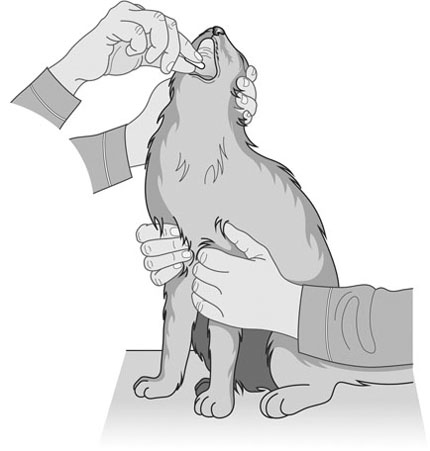1. Energy requirement – a healthy animal needs energy for basic metabolism and for exercise. A sick animal will use much less energy in exercise but disease and stress increase the normal energy requirements. 2. Type of food – sick animals often have a reduced desire to eat and thought must be given to palatability and how to tempt them to eat. If the animal does eat it may only eat small quantities, giving rise to the need to supply energy-dense food. In addition, the consistency must be considered in relation to the route of administration. 3. Route of administration: nutritional support can be given by the enteral route – making use of the gastrointestinal tract – or by the parenteral route – providing nutrients intravenously. In some cases a patient may not be able to use part of the gastrointestinal tract, e.g. the oral cavity, and steps must be taken to bypass it using some form of feeding tube. This chapter considers all these factors and describes in detail the techniques involved in placing feeding tubes and the nursing care needed to maintain them. (Administration of nutritional support using the gastrointestinal tract) 1. Action: Calculate basic energy requirement (BER) for over 5 kg bodyweight. Formula: BER = (30 × kg bodyweight) + 70 kcal. For example, to find the BER for a 10 kg dog: 2. Action: Calculate daily BER for 5 kg bodyweight and under. Formula: BER = (60 × kg bodyweight) + 70 kcal. For example, to find BER for a 3 kg cat: 3. Action: Calculate illness energy requirement (IER) in relation to daily BER: 1. Action: Calculate quantity of kcal to be fed to a hospitalized 10 kg dog. For example, 10 kg dog requires 370 kcal/day at rest: 2. Action: Calculate the quantity of food in ml to be fed to a 10 kg hospitalized dog. Food value 1.5 kcal/ml. For example, dog requires 444 kcal/day: 3. Action: Divide quantity in ml into equal feeds to be administered throughout the day: N.B.: Larger tubes, such as gastrostomy tubes, allow for larger quantities to be administered at each feed – calculations can be adjusted accordingly. 1. Action: Select and prepare equipment – check expiry date of food; prewarm food; wash hands; wear gloves and apron; damp swabs, towel. 2. Action: Reassure patient and ask the assistant to restrain the patient, holding the head in a normal position. 3. Action: With gloved hands, take a small quantity of food. Open the patient’s mouth and place some food on the back of the tongue (Fig. 5.1). 4. Action: Allow the patient to swallow and lick its lips, reassuring it throughout the procedure. Rationale: Encourage patient to swallow by externally massaging the ventral pharynx. 5. Action: Repeat until required amount of food has been administered. 6. Action: Once all food has been administered, clean the patient’s mouth with damp swabs and dry the area. Rationale: The mouth must be free of any food debris to discourage bacterial growth. 7. Action: Record food administration and repeat at required intervals. Rationale: It is essential to keep accurate records of food administration to prevent any error. 8. Action: Dispose of equipment safely and appropriately. Rationale: This is essential to avoid contamination. 9. Action: Any food in tins must be covered and stored at 4–8°C between feeds. 1. Action: Select and prepare equipment – calculate energy requirements and food quantity. Prewarmed food, catheter tip syringe, towel, assistant; wash hands, wear gloves and apron. 2. Action: Measure correct volume of food into syringe. Rationale: Accurately measure volume required based on calculation of energy/kcal needed. 3. Action: Request assistance to hold patient. Rationale: Ensure patient feels safe. 4. Action: Support patient’s nose and mouth, keeping the head in a normal position. 5. Action: Introduce the syringe into the mouth between the upper and lower premolars above the surface of the tongue. Rationale: This area is the most suitable to aid administration and control food intake. 6. Action: Applying gentle pressure to the syringe, introduce approximately 10 ml of food into the mouth and allow patient to swallow. Stroke ventral aspect of pharynx to encourage swallowing. 7. Action: Continue with administration until the required volume has been delivered. 8. Action: Clean and dry the patient’s mouth thoroughly and replace in kennel. 9. Action: Record food administered. Rationale: Accurate record keeping is essential to avoid error. 10. Action: Dispose of equipment safely and appropriately. Clean and disinfect surface areas. Rationale: It is essential to dispose of equipment correctly to avoid contamination.
Provision of nutritional support
INTRODUCTION
ENTERAL FEEDING
Procedure: Calculation of energy needs



Procedure: Calculation of food quantities to be administered



Procedure: Forced feeding – placing food in mouth
Food choice

Procedure: Forced feeding by syringe
Food choice
![]()
Stay updated, free articles. Join our Telegram channel

Full access? Get Clinical Tree


